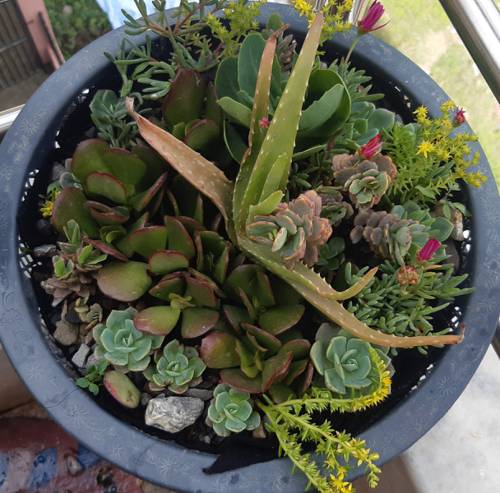
FAQ About Indoor Plant Species Revitalization

What are some common signs that an indoor plant needs revitalization?
Common signs that indoor plants need revitalization include yellowing leaves, stunted growth, dropping leaves, discoloration, and a lack of new growth. These symptoms can indicate various issues such as overwatering, underwatering, insufficient light, or nutrient deficiencies.

How can I rejuvenate an indoor plant suffering from overwatering?
To rejuvenate a plant suffering from overwatering, first ensure the plant's pot has adequate drainage holes to allow excess water to escape. Remove the plant from its pot and allow the root system to dry out completely. Trim away any roots that appear rotten or soft. Repot using fresh, well-draining soil and reduce future watering to only when the top inch of soil feels dry.

What steps should I take to save an indoor plant that has become root-bound?
To save a root-bound plant, gently remove the plant from its pot and tease the roots to free them. You may need to trim some of the outer roots if they are tightly compacted. Repot the plant in a larger container with fresh soil, giving the roots space to spread. Ensure the soil is well-drained to prevent future root-binding issues.

How can I identify nutrient deficiencies in indoor plants?
Nutrient deficiencies in indoor plants can manifest through symptoms like yellowing leaves, purpling of leaves, poor root development, and elongation of stems. Conducting a soil test can help determine specific deficiencies. You can then address these by adding appropriate fertilizers or soil amendments based on the identified deficiency.

What is the importance of pruning in plant revitalization?
Pruning is essential for plant revitalization as it encourages new growth and helps remove dead or diseased parts of the plant. Regular pruning also helps maintain the plant's shape, prevents overcrowding, and can reduce the spread of pests and diseases. Always use clean, sharp tools to prevent damage and infection.

Can changing the light conditions help revitalize indoor plants?
Yes, altering light conditions can significantly affect a plant's health. Ensure your plants are receiving the right amount of light for their species, whether it's direct sunlight, partial shade, or full shade. Using grow lights can help supplement natural light and promote healthy growth, especially in rooms with limited sunlight.

What are effective strategies to deal with pest infestations in indoor plants?
To deal with pest infestations, first identify the type of pest affecting your plant. Common pests include aphids, spider mites, and mealybugs. Use insecticidal soap or neem oil as a natural remedy to eliminate pests. Regularly cleaning leaves and ensuring proper air circulation can also help prevent pest infestations.

How often should I fertilize indoor plants to promote revitalization?
Fertilizing frequency depends on the species of the plant and its growth stage. Generally, indoor plants benefit from being fertilized every 4-6 weeks during the growing season (spring and summer). Use a balanced, water-soluble fertilizer, but avoid over-fertilizing, as this can harm plants. Adjust the fertilization schedule for dormant periods in fall and winter.

What role does humidity play in indoor plant health?
Humidity plays a critical role in indoor plant health, affecting transpiration and nutrient uptake. Many tropical indoor plants thrive in higher humidity levels. Increase humidity using a humidifier, placing water trays near plants, or regularly misting leaves. Ensuring adequate humidity can prevent issues such as leaf browning and wilting.

How can I successfully repot an indoor plant to aid its revitalization?
To successfully repot an indoor plant, choose a pot that is one size larger than the current one with good drainage. Remove the plant carefully, shaking off old soil. Trim any dead roots and spread healthy ones outward. Place the plant in the new pot and fill with fresh, well-draining soil. Water the plant thoroughly and place it in an optimal light condition.

Is it beneficial to dust and clean indoor plant leaves?
Yes, dusting and cleaning indoor plant leaves is beneficial as it improves photosynthesis efficiency. Dust accumulation can block sunlight, hindering growth. Use a damp cloth to gently wipe leaves or give the plant a lukewarm shower. Regular cleaning also helps reduce pest issues and improves the plant's appearance.

How can stress from environmental changes affect indoor plants?
Environmental stressors such as temperature fluctuations, poor lighting, and inadequate humidity can negatively impact indoor plants. Stress may lead to leaf drop, failure to thrive, and an increased susceptibility to diseases. Keeping environmental conditions stable helps reduce stress and promotes plant health.

What are signs of a pest infestation in indoor plants?
Signs of pest infestation include leaf discoloration, sticky residue on leaves, webbing, small holes, or visible pests on the plant. Identifying these early can help manage infestations quickly. Regular inspections and cleaning are key in keeping plants pest-free.

How do I know if my indoor plant is getting enough light?
Signs of insufficient light include leggy growth, pale leaves, and slow growth. Conversely, too much light can lead to leaf burn or curling. Adjust the plant's position or use artificial grow lights to achieve optimal light conditions for its specific needs.

Can trimming back a plant help with vitality?
Yes, trimming can promote vitality by removing dead or unhealthy growth, allowing the plant to concentrate energy on new, healthy growth. It can also help shape the plant and reduce stress from excessive foliage.

How does temperature affect indoor plant revitalization?
Temperature affects metabolic rates and enzyme activity in plants. Extreme temperatures can cause distress, while optimal ranges promote health. Most indoor plants thrive in temperatures between 65-75°F (18-24°C). Avoid placing plants near drafts or heat sources which can disrupt their temperature balance.

How can I improve the soil quality for indoor plants?
Enhancing soil quality involves checking for the right balance of nutrients and good drainage. Mix organic matter, such as compost, into the soil to improve quality. Soil aeration, through gentle tilling, can also enhance root penetration and growth.

Are there specific plants that are easier to revitalize indoors?
Yes, some plants are more resilient and easier to revitalize, such as pothos, peace lilies, and snake plants. These species tolerate diverse conditions and rebound quickly from neglect with proper care. Consider these if you're starting on plant revitalization.

Can household remedies help in revitalizing indoor plants?
Household remedies like diluted apple cider vinegar, coffee grounds, and banana peels can benefit plants by providing nutrients and improving soil acidity. Ensure remedies are properly prepared to avoid harming plants. Testing a small area first can prevent potential damage.

What preventive measures can ensure indoor plant longevity and vitality?
To ensure longevity and vitality, regularly monitor plants for signs of stress or disease. Keep watering, light, and soil conditions optimal, and perform regular maintenance activities like pruning and cleaning. Additionally, rotating plants for even growth and adjusting care routines seasonally support healthy growth.
